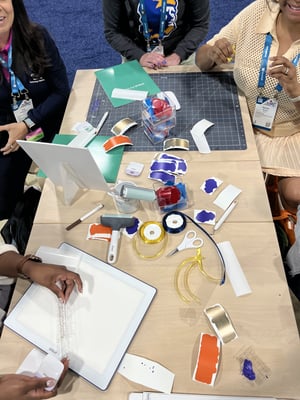Polygon Shaped Snowflakes



Description of Cricut Lesson & Activity
Students create digital paper snowflakes resembling hand-cut ones from childhood. They use mouse skills to make polygonal cuts on a digital rectangle, (https://dangries.com/rectangleworld/PaperSnowflake/) resulting in symmetrical snowflakes. They can craft abstract or symbolic snowflakes, and download them as .png files, and express themselves creatively.
- Arts and Crafts
- Design and Technology
- Digital Arts
- Engineering
- Fun, Graphic Design
- Holiday
- Mathematics
- Student Gifts
ISTE Standards
- 1.1 Empowered Learner
1.1a Learning Goals, 1.1d Technology Fundamentals
- 1.2 Digital Citizen
1.2.c Safeguard Well-being
- 1.3 Knowledge Construction
1.3.b Evaluate Information
- 1.4 Innovative Design
1.4.a Design Process, 1.4.b Design Constraints, 1.4.c Prototypes, 1.4.d Open-Ended Problems
State / Local / Other Standards
CCSS.ELA-LITERACY.W.3.6: Use technology to produce and publish writing (designs) as well as to interact and collaborate with others.
CCSS.MATH.CONTENT.3.G.A.1: Understand that shapes in different categories may share attributes and that the shared attributes can define a larger category (e.g., polygons).

For full project details, open in Cricut Design Space.
Click Here
For full project details, open in Cricut Design Space.
Click Here
Click Here
For use in your classroom, download full lesson plan.
Download Here

For full assessment rubric, download here.
Download Here
Learning Objective(s)
- Students will develop and practice their mouse skills by creating polygonal "scissor cuts" on a virtual paper rectangle.
- Students will demonstrate creativity and self-expression by designing unique digital snowflakes that reflect themselves.
- Students will learn how to save their creations as .png files and upload them to Cricut Design Space to create physical snowflake designs.
Materials Required
- Computers with internet access
- Access to https://dangries.com/rectangleworld/PaperSnowflake/
- Cricut Design Space software
- Projector and screen for demonstration
- Mouse / trackpad (chromebook) for each student
- Printer (optional, for printing designs)
Instructions
1. Introduction (10 minutes)
- Hook: Show a short video or slideshow of intricate paper snowflakes to spark interest.
- Discussion: Ask students about their experiences with creating paper snowflakes. Highlight the idea of symmetry.
- Objective Overview: Explain that they will be creating digital snowflakes using mouse skills and designing them to reflect their own creativity.
2. Direct Instruction (15 minutes)
- Demonstration: Use a projector to show how to navigate to Rectangle World Pa11er Snowflake.
- Modeling: Demonstrate how to create polygonal cuts on a virtual rectangle and emphasize symmetry.
- File Saving: Show students how to save their creations as .png files.
- Cricut Design Space Upload: Briefly explain how these files can be uploaded to Cricut Design Space. ( Teacher will do this part once students share their .png files)
3. Guided Practice (20 minutes)
- Partner Work: Students work in pairs to practice creating polygonal cuts. Teachers circulate to provide individual support and feedback. Focus: Encourage students to experiment with abstract or symbolic designs, reminding them about maintaining the integrity of the snowflake for cutting.
4. Independent Practice (30 minutes)
- Design Creation: Students create their own digital snowflakes, focusing on creativity and personal expression.
- File Management: Students save their designs and practice uploading to Cricut Design Space with guidance.
- Teacher Support: Provide help as needed, ensuring each student understands the process.
5. Conclusion (10 minutes)
- Reflection: Have students share their designs with the class and explain their creative choices. ( share digital files, not cut files)
- Discussion: Discuss what they learned about symmetry, creativity, and digital design tools
- Feedback: Collect feedback on what students enjoyed and found challenging
Assessment
- Observation: Monitor mouse skills and ability to create symmetrical designs during guided and independent practice.
- Design Review: Evaluate saved snowflake designs for creativity, symmetry, and adherence to design constraints.
- Reflection: Assess student reflections on their learning experience and creative process.
